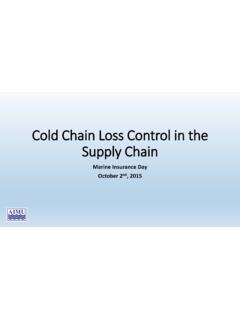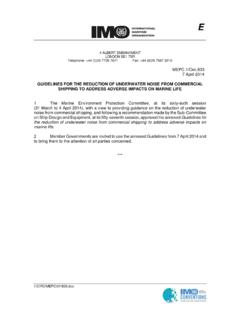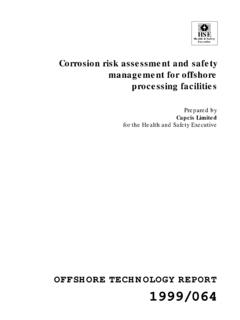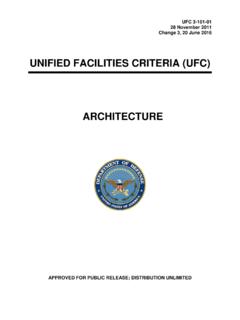Transcription of THE AUTHORIT ON SUSTAINABLE BUILDIN wwwlevelorgn
1 AUTHORITY ON SUSTAINABLE BUILDINGA luminiumAluminium is mainly used in New Zealand homes as the raw material for window frames. Aluminium is also sometimes used for roof and wall cladding. Its use as a balustrading system is increasing. BRANZ 2013 Extraction and manufactureImpact of extractionBauxite mining has significant visual impact and run-off must be contained on site. There is also potential for damage to local ecosystems during raw materialextraction. Is the bauxite sourced from a mine that has in place environmental control and a land rehabilitation programme?Bauxite supplied to NZ is taken from tropical rainforest large amount of raw material is needed to produce a small amount of final product the ratio is about 6 to useEmbodied energy quotes1 for aluminium are:Virgin: 194 MJ/kgExtruded: 204 MJ/kgExtruded anodized: 230 MJ/kgExtruded factory painted: 220 MJ/kg Recycled: 9 MJ/kgRecycled, extruded: MJ/kg Recycled, factory painted: 22 MJ/kgOn average it takes some kWh of electricity to produce one kilogram of aluminium from alumina ( for NZ smelter).
2 By-products/emissionsProcessing of bauxite into aluminium results in large quantities of waste (called red mud ). Manufacturers claim that the residue, while highly alkaline and containing traces of heavy metals and other hazadous substances, is chemically stable and non-toxic. Refining of bauxite for New Zealand production is carried out in by-product of the smelting process (called potliner ) contains fluoride and chlorine and must be disposed of as hazardous IAI (International Aluminium Institute) member smelters have equipment that removes 96-99 % of all fluoride emissions from the pots and re-uses them. Current average emission levels to atmosphere are around ( for the new modern plants) of fluoride per tonne of aluminium ( kg per tonne in 1974).SourcingMaterial sourcesRaw aluminium is manufactured in New Zealand (Bluff) from imported refined raw materials (Weipa open cast mine in Australia). Window sections are extruded in Auckland and Hamilton, and assembled locally.
3 Cladding planks are extruded in Auckland. Flat cladding panels are made in Auckland or imported. Roofing profiles are rolled in main centres throughout New building components are readily available throughout New costs are higher than for comparable steel wall and roof cladding. Uncoated wall and roof cladding material can be used in marine environments without an applied windows and doors are generally cheaper than timber or AUTHORITY ON SUSTAINABLE BUILDINGT ransport to siteAluminium is typically light to transport. Components such as windows can be bulky, but are generally assembled and safety during construction/installationThere are no currently known health and safety issues. Ease of construction/ installationAluminium is relatively lightweight and easy to aluminium products are easy to moderately easy to and safety during life of buildingAluminium is inert and not subject to off-gassing. It is suitable for roof water catchment.
4 Some concerns have been raised overseas of a possible Alzheimer s link but evidence is not capabilityAluminium has a low to medium strength-to-weight durability (assuming correct installation and maintenance)25-40 years serviceable life for aluminium windowsProfiled aluminium cladding should last more than 50 years depending on cleaning and is more durable than steel in similar environments, particularly when used without a paint ratingLow to medium for cladding but this depends on the environment, coating, and frequency of cleaningMoisture resistanceAluminium is impermeable to , mould and corrosionPinhole corrosion can occur in damp conditions if aluminium is unprotected or dirty or bird droppings are not removed by rain performanceNo thermal insulation or thermal mass is provided the rate of heat transfer is thermal performance of aluminium window sections can be substantially improved by the use of a thermal break in the frame section to restrict heat insulationNegligible thin material can vibrate and assist sound performanceAluminium won t burn.
5 But will melt in a hot disposal/recycling/re-useRe-useAluminium windows and cladding in good condition can be and pure aluminium can be recycled. Recovery of embodied energy is high when recycling recycling aluminium requires less than 20% of the energy of refining and some aluminium alloys cannot be readily disposalAluminium should be recycled where possible. 1. Embodied energy figures taken from work J. Andrew Alcorn, 2010. (Alcorn, J. Andrew, Global Sustainability and the New Zealand House, a thesis submitted to Victoria University of Wellington in fulfilment of the requirements for the degree of Doctor of Philosophy in Architecture, Wellington, 2010.)









